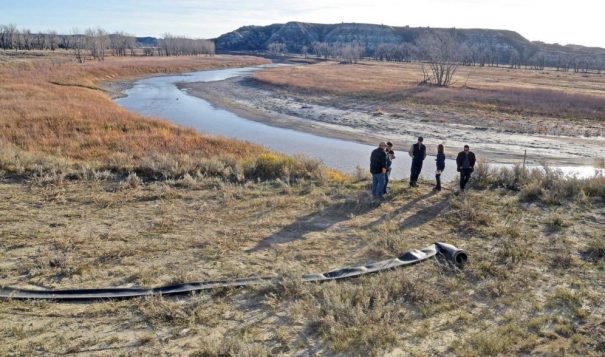 A flexible hose lies next to the Little Missouri River as oil company representatives tour the area in 2017. The hose is used in the process of sourcing water from the river for use by the oil industry for hydraulic fracturing in western North Dakota. - Tom Stromme
A flexible hose lies next to the Little Missouri River as oil company representatives tour the area in 2017. The hose is used in the process of sourcing water from the river for use by the oil industry for hydraulic fracturing in western North Dakota. - Tom Stromme
By Amy Dalrymple
DICKINSON − Members of the Little Missouri Scenic River Commission endorsed a state policy Monday that allows the oil industry to withdraw water from the river for hydraulic fracturing.
The advisory commission voted 6-1 to recommend that the State Water Commission continue its current policy related to temporary industrial water permits while also encouraging the agency to increase monitoring of river levels.
The State Water Commission, led by Gov. Doug Burgum, adopted an interim policy in June 2017 that allows temporary water permits to be granted for oilfield use with a set of conditions.
At the time, Burgum said he wanted input from the Little Missouri Scenic River Commission, a group he reactivated last year that includes adjacent landowners from counties along the river.
The advisory commission on Monday recommended that the State Water Commission continue with its policy but suggested some language be removed that specifies that pumps and motors be sheltered from view and required motors to be muffled to minimize audible disruption to the scenic river experience.
Members said the policy already requires precautions to be taken to minimize visual and audible disruption to the river valley.
Commission member Melissa Baker, director of the North Dakota Parks and Recreation Department, was the sole no vote, stating she believed the policy is stronger with the language commissioners recommended removing.
Commission Chairman Joe Schettler, who represents Dunn County, did not vote on the motion because he only votes in order to break a tie. Schettler disclosed during the meeting he holds a temporary industrial water permit.
Previously, the advisory commission had delayed taking action in order to get more information.
Jon Patch, director of water appropriations for the State Water Commission, told members about the agency’s efforts to increase monitoring of the Little Missouri River. The agency has added five new gages between the Long X Bridge and Medora, the portion of the river runs along Theodore Roosevelt National Park.
The goal of the monitoring program is to better understand the hydrology of the river to advise decisions on water appropriations and to ensure the river will be maintained in a free-flowing natural condition.
Since the monitoring program began this summer, permit holders have not pumped water out of the Little Missouri River during that segment for industrial use, Patch said.
Commission members voted to encourage the state agency to add similar monitoring downstream of the Long X Bridge where several permit-holders have pumped water this year for oilfield use.
Bridge debates
During the four-hour meeting, the advisory commission took no action on a controversial proposal to build a bridge across the Little Missouri River in Billings County after members could not reach a consensus.
Billings County is advocating for a river crossing, and a draft environmental impact statement identifies a preferred route that would cross private property near Medora.
Commission member Gene Allen of Golden Valley County made a motion to support the no-build option, but the motion failed 3-5.
In addition, the commission discussed a ranch bridge in Dunn County that is on private property on the east side of the Little Missouri but crosses Bureau of Land Management land on the west side.
The BLM, which learned about the bridge three years after it was complete, is initiating an environmental assessment to study the impacts of alternatives to resolve the issue, which could range from removing the bridge or granting a right-of-way for the bridge.
Members questioned how the U.S. Army Corps of Engineers granted a permit for the bridge without notifying the BLM.
“How is it possible that two agencies of the federal government concerning a bridge over this river could be acting so independently?” H. Patrick Weir, commission member from Billings County.
Members voted to send a letter to the Corps of Engineers directing the federal agency to notify the Little Missouri Scenic River Commission of future proposals to build bridges across North Dakota’s only state scenic river.
In this case, the river advisory commission was inactive at the time rancher Wylie Bice constructed it to connect his ranching operation.
“But boy going forward, I sure would want to get a notice,” Allen said.
The Little Missouri State Scenic River Act, adopted by North Dakota lawmakers in 1975, requires the river to be maintained in a free-flowing natural condition. The act also establishes the advisory commission, which was inactive between 2007 and 2017.
Several times during the meeting, members struggled with what the law requires and what their role should be related to bridge proposals. The law says the commission may advise units of government to protect and maintain the scenic, historic and recreational qualities of the Little Missouri River and its tributaries.
“It’s an ambiguous law, at best,” Weir said.
Jan Swenson, executive director of the Badlands Conservation Alliance, questioned what the future is for the Little Missouri River if its advisory commission won’t chime in on bridges that cross it.
“The people at this table have an incredibly unique and in my estimation an honorable position to speak for the state’s singular scenic river in a unique landscape that all North Dakotans care about,” Swenson said.
(Reach Amy Dalrymple at Amy.Dalrymple@bismarcktribune.com)
